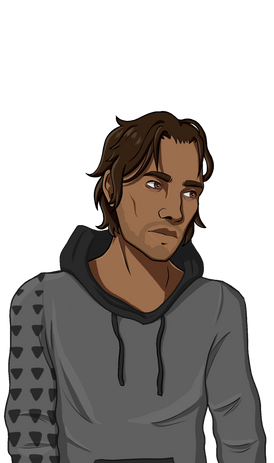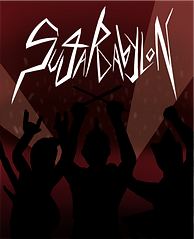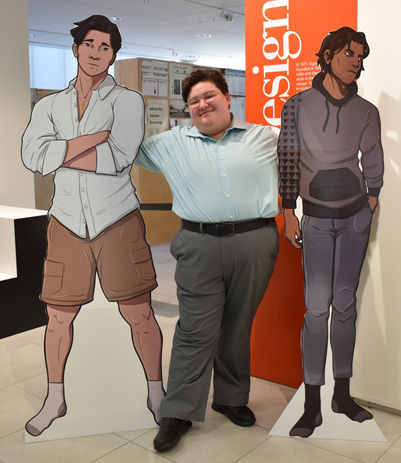
GET UP, GET OUT
An Interactive Visual Novel Experience
Artwork and Game Design by Louis Drum
Writing and Music by Sid Shukla

CURRENT GAME DEMO
April 20, 2025
The demo is now playable on itch.io!

Itch.io project page
On mobile? Watch the full game demo here!
Game Trailer
Introduction
I’ve always been extremely fascinated with development artwork for films and video games. You’ll catch me staring at an art book for hours, engrossed in the process of how a treasured piece of media was developed.
I learned I wanted to be a part of this process someday, designing assets for huge media projects. I can combine my adoration for illustration with all of the principles of the design process I’ve acquired while at RIT.
Working with the writings of Sid Shukla, I crafted my own game development experience in character design, branding, and user experience.
Sid is one of the most creative authors I know, and his work has never failed to awe me. I knew that when selecting a story-writer for my project, it would be him. I messaged Sid, asking if he’d be interested in a visual adaptation of any of his written work. He was immediately on board.
In September 2024, I proposed the idea of an adaptive media exhibit design, where I would propose the concept of a game along with merchandising and branding. They responded, “If you’re going to do that much, you need something to show for.”
I took that as a challenge
that started my spiral towards creating my own video game.

About Visual Novels
Visual Novels are one of the many ways a story can be told that aren’t in a traditional book format.
They’re a form of interactive media in which the player can self-pace themselves through a story with the assistance of illustrations, music, and sound effects to bring the characters and environment to life. They may also include additional aspects like mini games or choice-driven narratives.

Phoenix Wright: Ace Attorney - Dual Destinies- 2013/2024
Visual Novels make reading more accessible, digestible, and enjoyable for those who struggle with regular written media.
The Plot
Kabir’s life is unraveling, and it’s hard to say if it’s the pot, his mess of a relationship, or his failure to find a job. Stuck in a haze of weed and self-doubt, he’s on the brink of ruining his life. In a conflict with his band-mates, things go south when what he thought was only a hallucination turns violently real.
LINCOLN PARK, CHICAGO, IL, USA

Kabir ranting about his current hardships
GET UP, GET OUT (GUGO) is catered towards young adults aged 18+ for its use of strong language, recreational drug use, and disturbing imagery.
It represents the fears and struggles young adults have about their futures, adding a layer of surrealism that manifests those fears into a horrific physical entity.
The game guides the player through the story of the first chapter of Sid Shukla’s novel, familiarizing the player with the characters and setting of the rest of the story.
It features additional gameplay aspects to enhance the involvement of the player, and the overall entertainment of the game. Players will be able to be a part of the band in an interactive click-along rhythm game, and battle a fearsome monster that threatens Kabir and his friends.
Rhythm Game Demo
Characters
Before any development could begin, I needed to pinpoint the appearances of the main cast of characters.
Characters are the forefront of an effective visual novel.
Crafting an appealing cast allows players to connect with them on a personal level. Their appearances would define the art style and energy of the rest of my visual assets.



After pinning down the art style and the characters’ main features, I had a survey of 25 participants vote on the character designs of my four protagonists.
Sid’s preferred vision always took priority in the results, but the survey provided valuable additions to the character design, like beauty marks, accessory colors, outfit suggestions, and skin tones.




The Abomination

The Abomination is an amalgamation of the figures that torment Kabir most. In the same 25 participant survey, I asked what parts of the body people found most uncanny:
In the category of facial features, 80% voted for eyes, with teeth coming in second place.

Chunseong Chapter 2 Quote:
“‘…Eyes, Darcy.’ [...] ‘I took one look at her eyes and… oh God.’”
In the category of body parts, 80% voted for Hands/Fingers, with ribs coming in second place.

Chapter 1 Quotes:
“... eight gangrenous hands.”
“Steel rods, sticking out like some sort of exoskeletal structure.”
The Abomination does not have a set physical body. It’s a gloopy mess that imitates what it thinks a human should look like. The hands are not quite hands, it has hands instead of feet, and its physical form sags and pools around the magic steel rods that keep it upright.

The hands were inspired by the uncanny generated hands from Generative AI image models. The Abomination is a lot like AI, in the sense that it gets its idea of the human form based on Kabir’s thoughts and memories of people, and attempts to replicate it based on those images.



The steel rods have glowing red runes on the joints.
A new lettering system was created to hide messages in the runes, including the first letters of emotions, acronyms, and spelling phrases that are said throughout the first chapter.
The ends of some of the rods also jut out and have sharp points. I wanted to mimic the intimidating look of spider legs or mantis arms.
Asset Planning

To plan the necessary sprites*, environmental shots, and necessary assets, I went through the entirety of Chapter 1 and created a storyboard of the game.
This storyboard helped me gather a list of assets totaling up to
44 sprites and 35 cinematic shots.
The storyboard was also key in determining the dialogue pacing, and which dialogue pieces could be cut from the final.
*Sprites are illustrated assets that show characters and objects in different states or conditions.
Sid drafted a rough blueprint of the townhouse to give me a frame of reference for my cinematic shots. I slightly modified the layout of the garage for an ideal cinematic layout, and I mapped out character locations and camera angles that I would use to render scenes.



To streamline the creation of 35 cinematic shots, the environments were built in Fusion 360 using both original and free assets, depending on the object.




The scenes were rendered with a toon filter to blend with my art style.


Raw Keyshot Render
Illustrative Assets


Character Additions
Lighting Adjustments
Game Design

The game engine I used is called Visual Novel Maker by KOMODO. It provided the tools necessary to craft the style of game I wanted to create without the need for deep programming knowledge. With simple node-based commands, I was able to build my game exactly how I storyboarded.


While VNM was fantastic for building the majority of the game, it came with some unfortunate drawbacks and restrictions that I would have to work around:


The ideal UI layout would've had dynamic, animated text boxes and buttons. In order to implement them, however, it would've required higher programming knowledge in Coffeescript, as well as irregularly-shaped image maps (which were not possible within the software).
Ideal Dialogue UI

Ideal Battle UI
The battle sequence had to be dumbed down in the final, since the node format of programming the game could not account for enemy AI (how they pattern attacks), damage tracking (how much damage is dealt), and HP bar progress. A proper software for these features would be RPGMaker by the same company, however, integration between the two programs has not been figured out yet.

Rough Rhythm Game Concept
The rhythm game sequence was going to be a DDR/FNF-inspired input-based game that followed the bass notes of the theme song. I was not able to figure out timed inputs in time, and to make the game more stable, I opted for mouse inputs instead (so false key inputs didn't break the game demo).
The game in the final demo is a static video that does not track mouse inputs or score. I designed the video so there are also lyrics on screen that the user can sing along with, like karaoke.

Rhythm Game Tutorial Screen
To pace the dialogue so it wasn’t overwhelming and choppy, I found that breaking up lines during natural pauses in speech made it easier to digest and set the tone of voice the character would be using.
Some dialogue from the book had to be altered to clarify subjects or actions, since there was no written context for players to read.
“‘Kabir, we’re just… worried. And we’re trying to help! I guess, for Chunseong, that means changing a—a fucking chord to subtly inspire you. Nice job, by the way.’”




During our midterm capstone checkpoint, GUGO amassed a total of
42 playtesters, earning me valuable feedback.
Thanks to their input, key changes like tutorial messages, dialogue pacing, sound adjustments, and bug fixes were able to be implemented.

Photo Cred: Chris Baron
You can view the midterm game demo of Act I:
SONG DEMOS
Composed by Sid Shukla
Main Theme
“The Main Theme was written around the song lyrics from the original source material. The melody and rhythmic content follow the shape of the words, with a grungy instrumental that reflects the garage band aesthetic.”
Casual Background Theme
“The Idle Theme uses a combination of acoustic bass (a nod to the bass-playing Kabir) and 8-bit drums to reflect the stoned atmosphere of Apt 40.”
Battle Theme
“The Battle Theme uses rhythmic and melodic ideas from the main GUGO theme while cranking up the intensity. New synth elements and a heavy bass give the battle theme a darker feel, while the electric guitar and drum kit keep the track grounded in the established garage band sound.”
Tension Theme
"The Tension Theme features a massively reduced version of the Baek-Su melody on toy glockenspiel, retaining the stoned atmosphere while introducing a thumping heart-beat bass and uneasy shuffling drums. In other words, this theme explores the opposite side of the stoned spectrum as ‘Baek-Su:’ a bad high.
Gallery
READ THE BOOK!
Resources:
Dale, Laura. “Visual Novel Accessibility vs Books.” Access-Ability.uk, 25 Apr. 2022,
access-ability.uk/2022/04/25/visual-novel-accessibility-vs-books/.
Parker, Alvin. “Literacy Statistics in the US for 2025 (Data & Facts).” Prosperity for All,
20 Mar. 2025, www.prosperityforamerica.org/literacy-statistics/.
Queenie. “How Visual Novels Helped Me Read Again.” The Library, 18 Jan. 2020,
queerqueenlywriting.wordpress.com/2020/01/18/how-visual-novels-helped-me-
read-again/.
Richardson, Emily. “Nearly Half of College-Aged People Don’t Read for Pleasure.”
The Commonwealth Times, Virginia Commonwealth University, 6 Sept. 2023,
commonwealthtimes.org/2023/09/06/nearly-half-of-college-aged-people-dont-
read-for-pleasure/.
Strong, Brystan. “Video Games, Literacy, and Visual Novels.” Jackson County Library
District, 9 May 2023, jcls.org/2023/05/09/video-games-literacy-and-visual-novels/.
CAD Assets and References:
Erkko Agge: https://grabcad.com/library/leather-sofa-4
Bitmancer: https://bitmancer.gumroad.com/l/BPM_Pulse
Nícolas R. Bosquetti: https://grabcad.com/library/modified-stingray-bass-guitar-1
Max Field: https://grabcad.com/library/drum-kit-3
Dimitrios Katrisiotis: https://grabcad.com/library/fender-tom-delonge-stratocaster-signature-electric-guitar-1
Ryan Kelly: https://grabcad.com/library/marshall-dsl40-guitar-amp-1
Nick Van Laar: https://grabcad.com/library/music-stand
Marko Pospiech: https://grabcad.com/library/microphone-stand-for-singing-1
Mohamed Shams: https://grabcad.com/library/leather-couch-inspired-from-the-big-bang-theory-tv-show-1
Jean Louis De Smet: https://grabcad.com/library/condensor-microphone-1
software:
Adobe After Effects, Fresco, Illustrator, InDesign, Photoshop, Premiere Pro
Autodesk Fusion 360
Keyshot12
KOMODO Visual Novel Maker
Special Thanks:
I wanted to give a big thank you to Sid Shukla, not only for all that he’s done for this capstone, but for also being a huge joy to work with through this entire process.
Thank you to all of my ID Class of 2025 peers and the RIT ID community, and congratulations to all of you and your successful, fantastic work.
Thank you to my roommates Eva, Liam, and Cecilia (and honorary Nika) for suffering through my whining, complaints, and my need for emergency coding assistance.
Thank you Lori, Lara, and Mariana for allowing me to take on this crazy passion project of mine for my capstone, and for all of your enthusiastic support.
Thank you to my parents and family for financially supporting me through my time at RIT, and for encouraging me to pursue a career I’m passionate in.
Thank you to Chris Lyons for being my biggest believer, and the most amazing, passionate, sweet professor I’ve ever had the pleasure of getting to know.
Thank you, Shannon, for your love, support, and patience while I worked like crazy.

























































